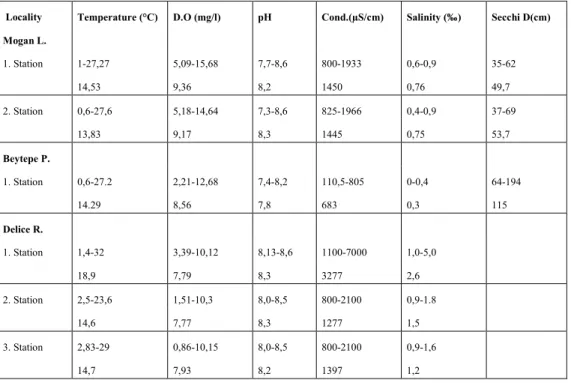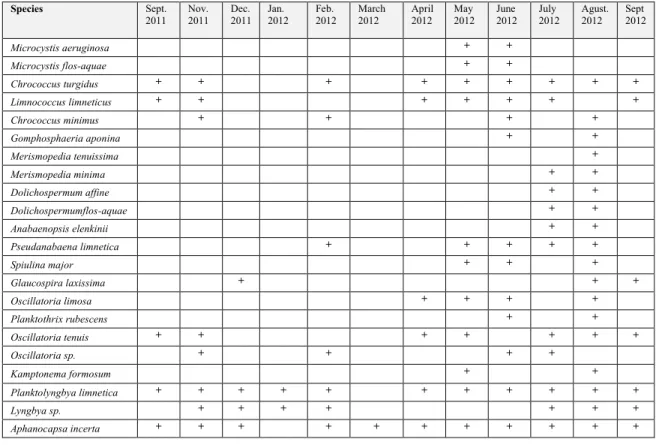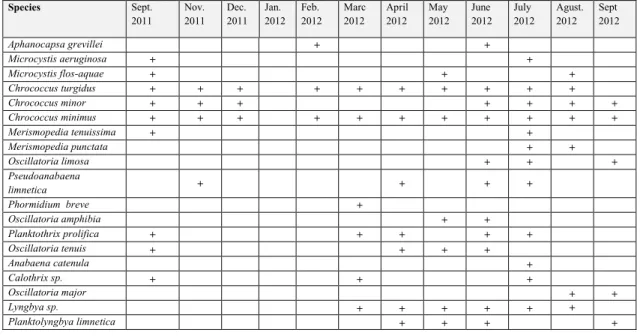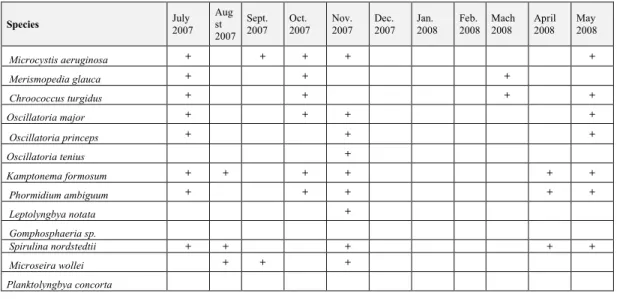Received by the editorsJuly 07, 2018; Accepted: August 04, 2018.
Key word and phrases: Delice River, Mogan Lake, Beytepe Pond, Cyanobacteria.
© 2018 Ankara University Communications Faculty of Sciences University of Ankara Series C: Biology THE INVESTIGATION ON THE BLUE-GREEN ALGAE OF MOGAN
LAKE, BEYTEPE POND AND DELİCE RIVER (KIZILIRMAK)
AYLA BATU and NURAY (EMİR) AKBULUT
Abstract. In this study Cyanobacteria species of Mogan Lake, Beytepe Pond and Delice River were taxonomically investigated. The cyanobacteria specimens have been collected by monthly intervals from Mogan Lake and Beytepe Pond between October 2010 and September 2011. For the Delice River the laboratory samples which were collected by montly intervals between July 2007-May 2008 have been evaluated.Totally 15 genus and 41 taxa were identified, 22 species from Mogan lake, 19 species from Beytepe pond and 13 species from Delice river respectively. During the study species like Planktolyngbya limnetica and Aphanocapsa incerta were frequently observed for all months in Mogan Lake, Chrococcus turgidus and Chrococcus minimus were abundant in Beytepe Pond while Kamptonema formosum was dominant in Delice River. As a result species diversity and density were generally rich in Mogan Lake during fall and summer season while very low in the Delice River during winter season.
1. Introduction
Cyanobacteria (blue-green algae) are microscopic bacteria found in freshwater lakes, streams, soil and moistened rocks. Even though they are bacteria, cyanobacteria are too small to be seen by the naked eye, they can grow in colonies which are large enough to see. When algae grows too much it can form “blooms”, which can cause various problems. Cyanobacterial Harmful Algal Blooms (CyanoHABs) are dangerous to humans, animals, and, the environment and can lead to a depletion of oxygen in the water and a release of toxins, as well as taste and odour problems [1-3]. Many studies have been done in Mogan lake since 1974 including hydrobiological aspects [4]; seasonal changes of phytoplankton and physico-chemical variables [5]; littoral algea [6]; algae of Mogan lake [7]; plankton composition [8]; phytoplankton communities and water chemicals [9-10]; macrophyte-dominated clear water status [11]; trophic status of the lake [12];
planktonic algae except Bacillariophyta [13]. Ünal [14] studied the composition of phytoplankton and bentic algae of Beytepe pond between June 1978-December 1979. Akbulut [15] listed 16 cyanobacter species from Beytepe pond. Atıcı et al. [16] observed 11 cyanobacteria species which consisted %16,1of the total algea in the Delice River.
The aim of of the present study is to investigate cyanobacteria in the ecologically different three habitats which were natural lake, man made lake and running waters to identify cyanobacteria species and observe the affect of the environmental variables.
2. Material And Methods 2.1. Study Area
This study has been carried out in three different water bodies (Mogan Lake, Beytepe Pond and Delice River). Mogan Lake is located 20 km south of Ankara within Gölbaşı province and one of the shallow lake, the area is aproximatelly 6.35 km2, average dept is 2-2.5 m and altitude is 972 m. The lake has been formed by tectonic activity. The major inflows to Lake Mogan (Gölbaşı) are Sukesen, Gölcük and Gölova brooks. Lake Mogan is Specially Protected Area since 1990 Akbulut and Akbulut [8] (Figure 1.a). Beytepe Pond is a man-made pond at approximately 970 m above sea level in Ankara province (Figure 1.b). To investigate cyanobacteria of Delice River, laboratory samples which were collected from three station in Kırşehir and Yozgat between July 2007-May 2008 (Project 07D06601001 Hacettepe University Research Fund) have been evaluated (Figure 1.c).
Table 1. Study area and sampling locality
Sampling
Locality Lake Province Altitude (m) Coordinates
1.Station Mogan Ankara 976 39°47’17.18”N 32°47’59.44” E 2. Station Mogan Ankara 975 39°46’42.19”N 32°47’48.26” E Sampling
Locality Pond Province Altitude (m) Coordinates
1. Station Beytepe Ankara 982 39°52 52.52 N 32°44’22.90” E Sampling
Locality River Province Altitude (m) Coordinates
1. Station Delice River Kırşehir 702 39°48.161 N 34°06.139 E 2. Station Delice River Yozgat 1154 39°38.414 N 34°28.183 E 3. Station Delice River Kırşehir 702 39°42.924 N 34°15.379 E
a.
Mogan Lakeb. Beytepe Pond
c. Delice River
2.2. Sampling
Sampling was carried out from one locality from Beytepe pond and two localities in Mogan Lake one is located in littoral while the other station is located in the open water. Sampling was carried out between October 2011–September 2012. For Delice river laboratory samples from three different localities have been evaluated. During the study, samples were collected with a plankton net of 33μm mesh size and patala sampler (volume capacity of 17 litres). Algae samples were also collected by scraping from stones and macrophyte and the specimens were fixed in 4% formaldehyde.
Dissolved oxygen, conductivity, salinity, pH and temperature were also measured at the sampling stations using field instruments (CONSORT C 933) and Secchi disc transparencies were measured using a 20 cm diameter secchi disc [17,36].
3. Results
Dissolved oxygen, temperature, salinity, Conductivity, pH and Secchi Dept were the measured environmental parameters. Dissolved oxygen is an important environmental parameter.
During the study measured dissolved oxygen value was 5,09 mg/l in May 2012 and 15,68 mg/l in March 2012 at the 1. Station in Mogan Lake; 2,21 mg/l in July 2007 and 12,68 mg/l in October 2007 in the Beytepe Pond while 0,86 -10,3 mg/l in Delice River. Temperature was fluctuated between 0,6-27,27 °C in Mogan lake; 0,6-27,2 °C in Beytepe Pond and 1,4-32 °C in Delice river in winter and summer seasons respectivelly. High dissolved oxygen was recorded during winter season all the study sites, it may be due to low temperature and photosynthetic rate of phytoplankton communities that may results in higher values of dissolved oxygen.
pH value was generally alkali condition in the three habitats and were changed between 7,3 8,6. PH value was increased generally in August in the three sampling area, while slightly decreased in the winter periods. Conductivity and salinity values
were the highest value in Delice River, while the lowest value was measured in Beytepe Pond (Table 2).
Totally 15 genera and 41 taxon were identified from three different sampling locations (Table 3). Among them 22 species were identified in Mogan Lake, 19 species in Beytepe Pond and 13 species in Delice River respectively (Table 4-6). Species list is given according to www.algaebase.org. [18] The number of species were highest in Mogan lake, followed by Beytepe pond and Delice river, respectively. Chroococcus turgidus, Microcystis aeruginosa and Oscillatoria tenuis were the common species which were observed in the three habitat too.
Table 2. The min-max and mean values for the physical parameters (Temperature (°C), D.O (mg/l), pH, Cond. (µS/cm), Salinity (‰), Secchi Depth (cm)) measured during the study.
Locality Temperature (°C) D.O (mg/l) pH Cond.(µS/cm) Salinity (‰) Secchi D(cm)
Mogan L. 1. Station 1-27,27 5,09-15,68 7,7-8,6 800-1933 0,6-0,9 35-62 14,53 9,36 8,2 1450 0,76 49,7 2. Station 0,6-27,6 5,18-14,64 7,3-8,6 825-1966 0,4-0,9 37-69 13,83 9,17 8,3 1445 0,75 53,7 Beytepe P. 1. Station 0,6-27.2 2,21-12,68 7,4-8,2 110,5-805 0-0,4 64-194 14.29 8,56 7,8 683 0,3 115 Delice R. 1. Station 1,4-32 3,39-10,12 8,13-8,6 1100-7000 1,0-5,0 18,9 7,79 8,3 3277 2,6 2. Station 2,5-23,6 1,51-10,3 8,0-8,5 800-2100 0,9-1.8 14,6 7,77 8,3 1277 1,5 3. Station 2,83-29 0,86-10,15 8,0-8,5 800-2100 0,9-1,6 14,7 7,93 8,2 1397 1,2
Table 3. Identified taxa of Cyanobacteria Kingdom: Bacteria Phylum: Cyanobacteria Classis: Cyanophyceae Ordo: Chroococcales Family: Chroococcaceae Genus: Chroococcus 1. Chroococcus turgidus 2. Limnococcus limneticus 3. Chroococcus minimus 4. Chroococcus minor Family: Microcystaceae Genus: Microcystis 1. Microcystis aeruginosa 2. Microcystis flos-aquae Family: Gomphosphaeriaceae Genus: Gomphosphaeria 1. Gomphosphaeria aponina Ordo: Synechococcales Family: Merismopediaceae SubFamily: Merismopedioideae Genus: Merismopedia 1. Merismopedia glauca 2. Merismopedia minima 3. Merismopedia punctata 4. Merismopedia tenuissima Ordo: Synechococcales Family: Merismopediaceae Genus: Aphanocapsa 1. Aphanocapsa grevillea 2. Aphanocapsa incerta Family: Pseudanabaenaceae Genus: Pseudnanabaena 1. Pseudanabaena limnetica Ordo: Oscillatoriales Family: Oscillatoriaceae Genus: Oscillatoria 1. Oscillatoria sp. 2. Oscillatoria amphibia 3. Oscillatoria limosa 4. Oscillatoria princeps 5. Oscillatoria tenuis 6. Phormidium breve 7. Planktothrix rubescens 8. Planktothrix prolifica 9. Pseudoanabaena limnetica Genus: Lyngbya 1. Lyngbya sp 2. Lyngbya sp. 3. Lyngbya sp. 4. Oscillatoria major 5. Planktolyngbya limnetica 6. Planktolyngbya concorta Genus: Plectonema
1. Microseira wollei (Plectonema wollei) Family: Phormidiaceae
Genus: Phormidium
1. Kamptonema formosum (S: Oscillatoria formosa) 2. Phormidium ambiguum Ordo: Nostocales Family: Aphanizomenonaceae Genus: Anabaenopsis 1. Anabaenopsis elenkinii Family: Rivulariaceae Genus: Calothrix 1. Calothrix sp. Family: Nostocaceae Genus: Anabaena 1. Anabaena catenula
2. Dolichospermum affine (S:Anabaena affinis) 3. Dolichospermum flos-aqua
Ordo: Spirulinales
Family: Spirulinaceae
Genus: Spirulina
1. Glaucospira laxissima (S:Spirulina laxissima) 2. Spirulina major
3. Spirulina nordstedtii Ordo: Pseudanabaenales Family: Pseudanabaenaceae Genus: Leptolyngbya
Table 4. Seasonal distribution of the species in Mogan Lake.
Species Sept.
2011 Nov. 2011 Dec. 2011 Jan. 2012 Feb. 2012 March 2012 April 2012 May 2012 June 2012 July 2012 Agust. 2012 Sept 2012
Microcystis aeruginosa + + Microcystis flos-aquae + + Chrococcus turgidus + + + + + + + + + Limnococcus limneticus + + + + + + + Chrococcus minimus + + + + Gomphosphaeria aponina + + Merismopedia tenuissima + Merismopedia minima + + Dolichospermum affine + + Dolichospermumflos-aquae + + Anabaenopsis elenkinii + + Pseudanabaena limnetica + + + + + Spiulina major + + + Glaucospira laxissima + + + Oscillatoria limosa + + + + Planktothrix rubescens + + Oscillatoria tenuis + + + + + + + Oscillatoria sp. + + + + Kamptonema formosum + + Planktolyngbya limnetica + + + + + + + + + + + Lyngbya sp. + + + + + + + Aphanocapsa incerta + + + + + + + + + + +
Table 5. Seasonal distribution of the species in Beytepe pond. Species Sept. 2011 Nov. 2011 Dec. 2011 Jan. 2012 Feb. 2012 Marc 2012 April 2012 May 2012 June 2012 July 2012 Agust. 2012 Sept 2012 Aphanocapsa grevillei + + Microcystis aeruginosa + + Microcystis flos-aquae + + + Chrococcus turgidus + + + + + + + + + + Chrococcus minor + + + + + + + Chrococcus minimus + + + + + + + + + + + Merismopedia tenuissima + + Merismopedia punctata + + Oscillatoria limosa + + + Pseudoanabaena limnetica + + + + Phormidium breve + Oscillatoria amphibia + + Planktothrix prolifica + + + + + Oscillatoria tenuis + + + + Anabaena catenula + Calothrix sp. + + + Oscillatoria major + + Lyngbya sp. + + + + + + Planktolyngbya limnetica + + + +
Table 6. Seasonal distribution of the species in delice river.
Species July 2007 Augst
2007 Sept.
2007 Oct. 2007 Nov. 2007 Dec. 2007 2008 Jan. Feb. 2008 Mach 2008 April 2008 May 2008
Microcystis aeruginosa + + + + + Merismopedia glauca + + + Chroococcus turgidus + + + + Oscillatoria major + + + + Oscillatoria princeps + + + Oscillatoria tenius + Kamptonema formosum + + + + + + Phormidium ambiguum + + + + + Leptolyngbya notata + Gomphosphaeria sp. Spirulina nordstedtii + + + + + Microseira wollei + + + Planktolyngbya concorta 4. Discussion
The water temperature is of vital importance for living things in an aquatic environment. The water temperature in lentic habitats varies depending on the air temperature, the amount of dissolved matter, depth, surface area and the geographic location of the habitat [19] In recent years, the discharge of domestic, agricultural and industrial wastes into aquatic ecosystems has led to increased nutrients such as nitrogen and phosphorus in aquatic habitats. This situation is known to increase primer production and especially the blue-green cyanobacteria population in the waters, thus altering the structure of phytoplankton communities [20-23]. Many problems may arise if blue green algae increase excessively due to eutrophication in aquatic systems. Cyanobacterial blooms (CBs) are generally triggered by eutrophic conditions due to anthropogenic nutrient inputs to local waters (wastewater or
contaminated waters). During the bloom, some species produce toxic secondary metabolites (cyanotoxins) that are dangerous for humans and animals [24]. Some of the cyanobacter species produce neurotoxins which are harmful to biota [25]. Microcystis aeruginosa which is one of the important toxin producing algae and could be harmful when rich the high numbers in the water bodies [26]. In addition Phormidium genera can produce Anatoxin-a; Lyngbya can produce Saxitoxsin, Dermatoxsin, Lyngbyatoxsin-a and Aplysiatoxsin [27].
According to Manav and Yerli, Mogan is one of the eutrophic lake character [12]. The temperature was increased from May to september and reached to maxima in July. Dissolved oxygen levels exhibited an inverse relationship with temperature. Alkaline waters promotes high primary productivity [28]. During the study conductivity was high in January and pH was between 7,3-8,6 which was suitable for the growing cyanobacteria.
Akbulut and Akbulut [8] observed 15 cyanobacteria species from this lake while 22 taxa have been listed in our study and population density were increased generally in fall and summer season. Chrococcus sp., Merismopedia minima and Microcystis aeruginosa were the common species especially Chrococcus turgidus comprised %70,27 of the population in May and October when the water temperature was between 14-15 ºC. Lyngbya sp. was also increased at the same period too. Many researchers have reported that cyanobacteria are predominant during summer and early autumn [29]. This situation has also been observed in our work.
During the study 17 species and 2 genera have been observed from Beytepe pond while 5 species have been listed in the previous work and Chrococcus, Oscillatoria were the common genera Ünal [14]. According to the our results Chrococcus, Oscillatoria, Microcystis, and Lyngbya were the main taxa especially Chrococcus minutus was the most abundant species.
Although diversity was high in May, density was linearly increased in November (% 60,06) and in September (%53,75). Temperature levels fluctuated between 6,4 -20,4 ºC from September to November and pH changed between 7.8 and 7.9. During the study benthic taxa were slightly increased in April 2012 composed %16,41 of total population.
Delice River, is one of the branches of Kızılırmak River, which is the longest river of Turkey (1,355 km) and used for irrigation purposes in agricultural areas [30]. There are various studies on this stream ecosystem [31-35 ]. Water current is one the most important limiting parameter in the running waters. Sediment load increases in the rivers , the growth of phytoplankton decreases. During the study at least number of species recorded from river to compare lentic habitats. Atıcı [16] observed 11 cyanobacter taxa from Delice River and population composed %16,1 of total algea. According to this study Chrooccoccus turgidus and Merismopedia elegans were the common species. In our study 12 species and 1 genera have been identified amoung them Chrooccoccus turgidus and Oscillatoria formosa were the common species. The physico-chemical parameters are the major factors that control the dynamics and structure of the phytoplankton of aquatic ecosystem (37-38). According to the
results, there was no dangerous situation in terms of cyanobacteria bloom in the examined three habitats but it is beneficial to carry out monitoring studies of algae population together with major elements especially in the lenthic habitats.
Acknowledgements. This study is supported by H.U. Research Fund (Project No: 012 D06 601 001). Authors gratefully thank to Prof. Dr. Arif Gönülol and Doç Dr. Tülay Baykal Özer contribution of the cyanobacteria sepecies.
References [1] https://www.lgsonic.com/blogs/cyanobacteria.
[2] http://www.ucmp.berkeley.edu/bacteria/cyanolh.html. Cyanobacteria life history and ecology.
[3] S.W Wilhelm, Field methods in the study of toxic cyanobacterial blooms: results and insights from Lake Erie research. Adv Exp Med Biol. 619:50 (2008) 1-12. doi: 10.1007/978-0-387-75865-7_22.
[4] J.Tanyolaç, M. Karabatak, Determination of Biological and Hydrobiological Features of Mogan Lake, TÜBİTAK Protocol No: VHAG-J, 1974.
[5] O. Obalı, Mogan Gölü Fitoplanktonunun Mevsimsel Değişimi, Doğabilim Dergisi, 92 (8), (1984) 9-104.
[6] O. Obalı, A. Gönülol, Ş. Dere, Algal Flora in the Littoral Zone of Lake Mogan, Ondokuz Mayıs Üniversitesi Fen Dergisi, 1 (3), (1989) 33-53.
[7] A. Akbulut, Mogan Gölü’nün (Ankara) Bacillariophyta Dışındaki Planktonik Algleri ve Dağılımları, Gazi Üniversitesi Fen Bilimleri Enstitüsü Dergisi, Cilt: 14, (2001) No. 3
[8] N. Akbulut, A. Akbulut, The Plankton Composition of Lake Mogan in Central Anatolia, Zoology in the Middle Eeast, 27, (2002) 107-116.
[9] G. Aykulu, O. Obalı, A. Gönülol, The distribution of phytoplankton at some lakes in the vicinity of Ankara(in Turkish), Doğa Bilim Dergisi, 7, (1983) 277–288.
[10] S.V. Yerli, E. Kıvrak, H. Gürbüz, E. Manav, F. Mangıt, O., Türkecan, Phytoplankton Community, Nutrients and Chlorophyll a in Lake Mogan (Turkey); with Comparison Between Current and Old Data, Turkish Journal of Fisheries and Aquatic Sciences, 12, (2012) 95-104.
[11] S. L. Burnak, M. Beklioğlu, Macrophyte-dominated clearwater state of Lake Mogan, Turk Journal of Zoology, 24, (2000) 305-313.
[12] E. Manav, S.V. Yerli, An Assesment on the Trophic Status of Lake Mogan, Turkey, Fresenius Environmental Bulletin, 17(1), (2008) 3-8.
[13] A. Akbulut, K. Yıldız, Mogan Gölü'nün (Ankara) Bacillariophyta Dışındaki Planktonik Algleri ve Dağılımları, Gazi Üniversitesi Fen Bilimleri Dergisi, 14 (3), (2001a) 723-739.
[14] Ş. Ünal, Beytepe ve Alap Göletlerinde Algolojik Çalışmalar, Hacettepe Üniversitesi Fen Fakültesi Botanik Bölümü, Doktora Tezi, 1980.
[15] A. Akbulut, “Türkiye Tatlısu Algleri” Ali Demirsoy, Genel Zoocoğrafya ve Türkiye Zoocoğrafyası “Hayvan Coğrafyası”, 1007(19), (2002) 422-545. [16] T. Atıcı, M. Yılmaz, A. Gül, M. Kuru, Delice Irmağı Algleri, Gazi
Üniversitesi Fen Bilimleri Enstitüsü Dergisi, 16(1), (2003) 9-17.
[17] N. Akbulut, A. Batu, Mogan Gölü, Beytepe Göleti ve Delice Nehri (Kızılırmak) mavi-yeşil algleri üzerine incelemeler. Hacettepe Üniversitesi, Bilimsel Araştırmalar Birimi, Proje sonuç raporu, (2014).
[18] http://algaebase.org.
[19] H. Metin, Beytepe Göleti Zooplanktonik Organizmaların Tespiti ve Mevsimsel Dağılımlarının Belirlenmesi, Yüksek Lisans Tezi, Hacettepe Üniversitesi Fen Bilimleri Enstitüsü, ( 2005).
[20] T. Zohary, and R.D Roberts, Hyperscums and the population dynamics of Microcystis aeruginosa. Journal of Plankton Research, 12, (1990) 423.
[21] L. Naselli-Flores, and R. Barone, Phytoplankton Dynamics and Structure: A Comparative Analysis in Natural and Man-made Water Bodies of Different Trophic State, Hydrobiologia, 438, (2000) 65–74.
[22] E. Vardaka, M. Moustaka-Gouni, C.M. Cook,. and T. Lanaras, Cyanobacterial Blooms and Water Quality in Greek Waterbodies, Journal of Applied Phycology, 17, (2005) 391–401.
[23] I. Douterelo, E. Perona, P. Mateo, Use of Cyanobacteria to assess water quality in running waters, Environmental Pollution, 127(3), (2004) 77-84. [24] R.Teta, V. Romano, S.G Della, S. Picchio, C.D. Sterlich, A. M. G. D. Tullio,
V. Costantino and M. Lega, Cyanobacteria as indicators of water quality in Campania coasts, Italy: a monitoring strategy combining remote/proximal sensing and in situ data. Environmental Research Letters 12 (2), (2017). [25] R. Teta, G. Della Sala, E. Glukhov, L. Gerwick, W.H. Gerwick, A. Mangoni
and V. Costantino 2015 Combined LC-MS/MS and molecular networking approach reveals new cyanotoxins from the 2014 Cyanobacterial bloom in Green Lake, Seattle, Environmental Science and Technology 49, (2015) 14301–10.
[26] I. R. Falconer, A. M. Bresford, M.T Runnegar , Evidence of liver damage by toxin from a bloom of the blue-green alga, Microcystis aeruginosa, The Medical Journal of Australia, 1(11), (1983) 511-514.
[27] G. A. Codd, J. Lindsay, F. M. Young, L. F. Morrison, J. S. Metcalf, Harmful Cyanobacteria. From mass molalities to management measures, In: Huis-man J, Matthijs HCP, Visser PM (eds) Harmful cyanobacteria. Springer, Netherlands, (2005) 1-23.
[28] M.P. Kumar, C. Prabhahar, Physico-chemical parameters of river water: a review, International Journal of Pharmaceutical, 3, (2012) 1304-131.
[29] H.W. Paerl, Growth and reproductive strategies of freshwater blue-green algae (Cyanobacteria). In: Sandgren CD (ed) Growth and reproductive strategies of freshwater phytoplankton, Cambridge University Press, New York, (1998) 261–31.
[30] N. E. Akbulut, S. Bayarı, A. Akbulut, Y. Şahin, Rivers of Turkey. Rivers of Europa Edited by Klement Tockner, Christopher T. Robinson, Urs Uehlinger Elsevier , 700 p, in ISBN: 13.978.0.12-369449-2, (2009) 643-672.
[31] A. Hasbenli, K. Yıldız. Kızılırmak Nehrinin Bacillariophyta dışındaki Algleri Üzerinde Kalitatif Bir Çalışma, İstanbul Üniversitesi Su Ürünleri Dergisi, 1-2, (1993) 1-17.
[32] E. S. Neyran, A. Gönülol, Morphological and 18S rRNA analysis of Coccoid green algae isolated from lakes of Kızılırmak Delta, Turkish Journal of Biology, 36 (3), (2012) 247-254.
[33] Ö. Baytut, A. Gönülol, Phytoplankton distribution and variation along a freshwater-marine transition zone (Kızılırmak River) in the Black Sea, Oceanological and Hydrobiological Studies, 45 (4), (2016) 453-465.
[34] F. Maraşlıoğlu, E. N. Soylu, A. Gönülol, Chlorococcal Chlorophytes composition, community structure, and seasonal variations in the shallow lakes of Kızılırmak Delta, Turkey, Turkish Journal of Biology, 35 (1), (2011) 117-124.
[35] F. Maraşlıoğlu, A. Gönülol, G. B. Pelit, Tersakan Çayı (Samsun-Amasya, Türkiye) Epilitik Alglerinin Bazı Fizikokimyasal Değişkenlerle İlişkisi, Karadeniz Fen Bilimleri Dergisi, 6, (2016) 1-11.
[36] A. Batu. Mogan Gölü, Beytepe Göleti ve Delice Nehri (Kızılırmak) mavi-yeşil algleri üzerine incelemeler, Hacettepe Üniversitesi Fen Bilimleri Enstitüsü Bilim Uzmanlığı Tezi, 91s., (2017).
[37] S.B. Hulyal, B. B. Kaliwa, Dynamics of Phytoplankton in relation to physico-chemical factors of Almatti reservoir of Bijapur district, Karnataka State, Environmental Monitoring and Assessment, 153, (2009) 45-59.
[38] C. R. Sharma, N. A. Chauhan, The influence of physico-chemical parameters on phytoplankton distribution in a head water stream of Garhwal Himalayas: A case study, The Egyptian Journal of Aquatic Research, 42 (1), (2016) 11-21.
Current Address: AYLA BATU: Mersin University, Faculty of Medicine, Çiftlikköy, 33343 Mersin, Turkey.
E-mail:ayla.batu@gmail.com
https://orchid.org//0000-0003-3221-4292
Current Address: NURAY (EMİR) AKBULUT (Corresponding Author): Hacettepe University, Faculty of Science, Dept of Biology -Hydrobiology, 06800 Beytepe, Ankara, Turkey.
E-mail: emir@hacettepe.edu.tr




